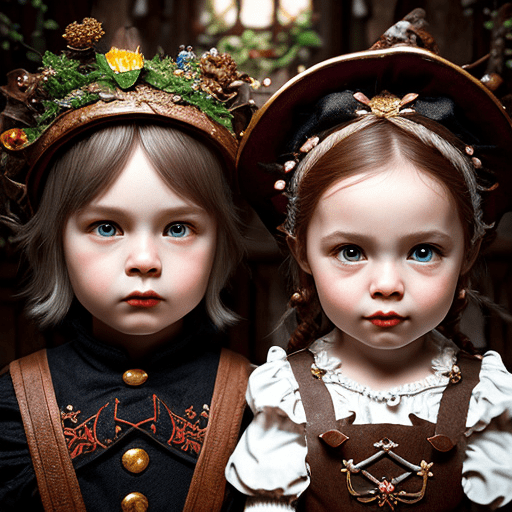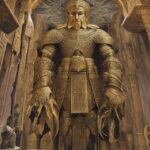“Hansel and Gretel” is a classic fairy tale that has been enjoyed by generations of children and adults alike. It tells the story of two siblings who are abandoned in a forest and fall into the hands of a witch who lives in a gingerbread, cake, and candy house.
In this article, we will provide a detailed summary of the story, along with analysis, characters, moral lesson, themes, symbolism, culture impact, and FAQs.
Short Story of Hansel and Gretel
Once upon a time, in a small village nestled deep within a dense forest, lived two siblings named Hansel and Gretel. They were kind-hearted and full of curiosity, always seeking new adventures. However, their lives took a turn when their father remarried a wicked woman named Gertrude, who had two daughters of her own.
Gertrude was jealous of Hansel and Gretel’s happiness and plotted to get rid of them. One day, she convinced their father to abandon the children in the heart of the forest, claiming they were a burden. Reluctantly, their father agreed, unable to stand up against his new wife’s wickedness.
Hansel, being clever, overheard their plan and decided to leave a trail of breadcrumbs behind them as they ventured into the unknown forest. Little did they know, the forest was enchanted, and the birds quickly devoured the breadcrumbs, leaving the children lost and alone.
As night fell, Hansel and Gretel stumbled upon a peculiar cottage made entirely of gingerbread and candy. Their eyes widened with delight, and their stomachs grumbled with hunger. They couldn’t resist taking a bite from the house, only to realize it belonged to a wicked witch.
The witch, named Hilda, had a sinister plan of her own. She lured children into her cottage, fattened them up, and then devoured them. Hilda’s beady eyes gleamed with excitement as she saw Hansel and Gretel standing at her doorstep.
However, Hansel and Gretel were no ordinary children. They were brave and quick-witted. Hilda invited them inside, pretending to be kind, but the children sensed her true intentions. They devised a plan to outsmart the witch and escape.
Hilda ordered Gretel to cook a delicious meal while she locked Hansel in a cage, planning to fatten him up for her feast. But Gretel, being clever like her brother, pretended to be confused and asked Hilda to demonstrate how to check the oven’s temperature.
As Hilda bent down to show Gretel, the young girl pushed her into the oven, slamming the door shut. The wicked witch let out a blood-curdling scream as she met her fiery demise.
With Hilda gone, Hansel and Gretel found the key to the cage and set themselves free. They discovered a chest filled with gold and precious gems, which Hilda had collected from her previous victims. The children decided to take the treasure back to their village, hoping it would help their father see the truth about his new wife.
As they made their way back through the forest, they stumbled upon the same birds that had devoured their breadcrumbs. The birds, grateful for their freedom from the witch’s clutches, guided Hansel and Gretel safely home.
When they arrived, their father was overjoyed to see them. He had realized the wickedness of Gertrude and regretted his actions. The treasure they brought back served as proof of the evil stepmother’s intentions, and she was banished from the village forever.
Hansel and Gretel lived happily ever after, their bond stronger than ever. They shared their treasure with the villagers, bringing prosperity and joy to their once-troubled lives. And from that day forward, the siblings were known as the heroes who outsmarted the wicked witch and brought light back into their village.
Hansel and Gretel Original Story Summary
The story begins with Hansel and Gretel, two siblings who live with their father and stepmother in a small village. The family is poor, and the stepmother convinces the father to abandon the children in the forest so that they will not have to feed them. Hansel overhears the plan and gathers pebbles to leave a trail back home.
The next day, the family goes into the forest, and Hansel leaves a trail of pebbles behind. The children are able to follow the trail back home, but the stepmother is angry and convinces the father to abandon the children again. This time, Hansel leaves a trail of breadcrumbs, but the birds eat them, and the children become lost in the forest. They come upon a gingerbread, cake, and candy house, and they begin to eat it.
The witch who lives in the house captures them and plans to eat them. Hansel and Gretel are able to outsmart the witch and escape back home with her treasure.
Analysis
The story of “Hansel and Gretel” is a timeless classic that has captured the imaginations of children and adults for generations. It is a story about the power of wit and the importance of family. The characters in the story are all unique and interesting, from the brave and clever Hansel to the resourceful and quick-thinking Gretel. The story is full of action and adventure, with magical creatures and fantastical settings that will capture the imagination of any reader.
Hansel and Gretel Story Characters
The characters in “Hansel and Gretel” are all unique and interesting, from the brave and clever Hansel to the resourceful and quick-thinking Gretel. Other notable characters include the father, the stepmother, and the witch who lives in the gingerbread, cake, and candy house.
Moral lesson of Hansel and Gretel Story
The moral lesson of “Hansel and Gretel” is that it is important to be brave and to protect your family. The story encourages readers to be resourceful and quick-thinking, and to stand up to bullies, no matter how big or powerful they may seem.
Themes
The themes of “Hansel and Gretel” include the power of wit, the importance of family, and the value of resourcefulness. The story encourages readers to be brave and to protect their loved ones, no matter what the cost. It also emphasizes the importance of resourcefulness and the value of thinking on your feet.
Symbolism
The symbolism in “Hansel and Gretel” is rich and complex, with many different interpretations possible. Some of the most notable symbols in the story include the gingerbread, cake, and candy house, which represents the illusions that people create for themselves, and the witch, which represents evil and danger.
Culture Impact
“Hansel and Gretel” has had a significant impact on popular culture, with many adaptations and spin-offs created over the years. The story has been adapted into numerous films, television shows, and stage productions, and it has inspired countless other works of literature and art.
FAQs
Q: What is the story of “Hansel and Gretel” about? A: The story of “Hansel and Gretel” is about two siblings who are abandoned in a forest and fall into the hands of a witch who lives in a gingerbread, cake, and candy house.
Q: Who are the main characters in “Hansel and Gretel”? A: The main characters in “Hansel and Gretel” include Hansel, Gretel, the father, the stepmother, and the witch.
Q: What is the moral lesson of “Hansel and Gretel”? A: The moral lesson of “Hansel and Gretel” is that it is important to be brave and to protect your family.
Q: What are the themes of “Hansel and Gretel”? A: The themes of “Hansel and Gretel” include the power of wit, the importance of family, and the value of resourcefulness.
Q: What is the symbolism in “Hansel and Gretel”? A: The symbolism in “Hansel and Gretel” is rich and complex, with many different interpretations possible. Some of the most notable symbols in the story include the gingerbread, cake, and candy house, which represents the illusions that people create for themselves, and the witch, which represents evil and danger.










